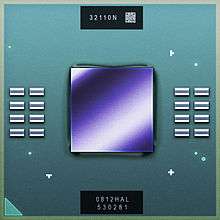SpursEngine

SpursEngine is a microprocessor from Toshiba built as a media oriented coprocessor, designed for 3D- and video processing in consumer electronics such as set-top boxes and computers. The SpursEngine processor is also known as the Quad Core HD processor. Announced 20 September 2007.[1]
The SpursEngine is a stream processor powered by four Synergistic Processing Elements (SPE),[2] also used in the Cell processor featured in Sony PlayStation 3. These processing elements are fed by on chip H.264 and MPEG-2 codecs and controlled by an off die host CPU, connected by an on chip PCIe controller[2] (in contrast to the Cell processor which has an on chip CPU (the PPE) doing similar work). To enable smoother interaction between the host and the SpursEngine Toshiba also integrated a simple proprietary 32-bit control core. The SpursEngine employs dedicated XDR DRAM as its working memory.[2]
The SpursEngine is designed to work at much lower frequencies than the Cell and Toshiba has also optimized the circuit layout of the SPEs to reduce the size by 30%.[3] The resulting chip consumes 10-20 W of power.
The SpursEngine is accessible to the developer from a device driver developed for Windows and Linux systems. Software supporting the SpursEngine is limited and is primarily in the realm of video editing and encoding.[4]
Technical specification

The first generation of SpursEngine processors are specified as follows:
- Built with a 65 nm bulk copper CMOS fabrication process with 7 metal layers[2]
- 9.98 mm × 10.31 mm (102.89 mm²) large die[2]
- 239.1 million transistors (Logic: 134 M, SRAM:104.8 M)[2]
- Thermal design power: <20 W[2]
- Max frequency: 1.5 GHz[2]
- Packaged in a 624 pin FC-BGA (Flip Chip-Ball Grid Array)[2]
- Peak performance at 48 Gflops, 12 Gflops per SPU @ 1.5 GHz.[5]
Commercialization
In April 2008 Toshiba shipped samples of the SpursEngine SE1000 device, a PCIe based reference board.[5]
- The accelerator card connects to a 1x PCI Express bus and has 128 MB XDR DRAM with 12.8 GB/s.
- Leadtek is producing the WinFast PxVC1100 and HPVC1100, internal and external PCIe accelerators based on the SE1000 platform.[6][7][8]
- Thomson-Canopus has announced the Firecoder Blu, a PCIe accelerator based on the SE1000 platform.[9]
Toshiba included the SpursEngine processors in their Qosmio laptops, models F50, G50 and G55, in the third quarter of 2008.
See also
References
- ↑ "New Toshiba SpursEngine based on CELL". I4U News. 2007-09-20. Retrieved 2009-11-14. External link in
|publisher=(help) - 1 2 3 4 5 6 7 8 9 10 "SpursEngine – Architecture Overview & Implementation" (PDF). Toshiba. 2008-10-09. Retrieved 2009-11-14.
- ↑ "How Far has Cell DNA been Passed On? Interview with Toshiba SpursEngine Developer". Tech-On! Nikkei Business Publications. 2007-10-17. Retrieved 2009-11-14. External link in
|publisher=(help) - ↑ "Toshiba to make SpursEngine an open platform - SDK to be released for free and multiple SpursEngine cards to run in parallel". HD Processing Forum. 2008-12-23. Retrieved 2010-01-04. External link in
|publisher=(help) - 1 2 "Toshiba starts sample shipping of SpursEngine SE1000 high-performance stream processor". Toshiba. 2008-04-08. Retrieved 2009-11-14.
- ↑ TechPowerUp.com
- ↑ Custompc.co.uk
- ↑ Akihabaranews.com
- ↑ Thomson-canopus.jp
External links
- Toshiba's Demos SpursEngine-Equipped Qosmio, Uses Cell Broadband Engine Technology, Gizmodo.com
- Cell Users Group - SpursEngine
- Cell-based GPU zaps laptop batteries, admits Toshiba – The Register